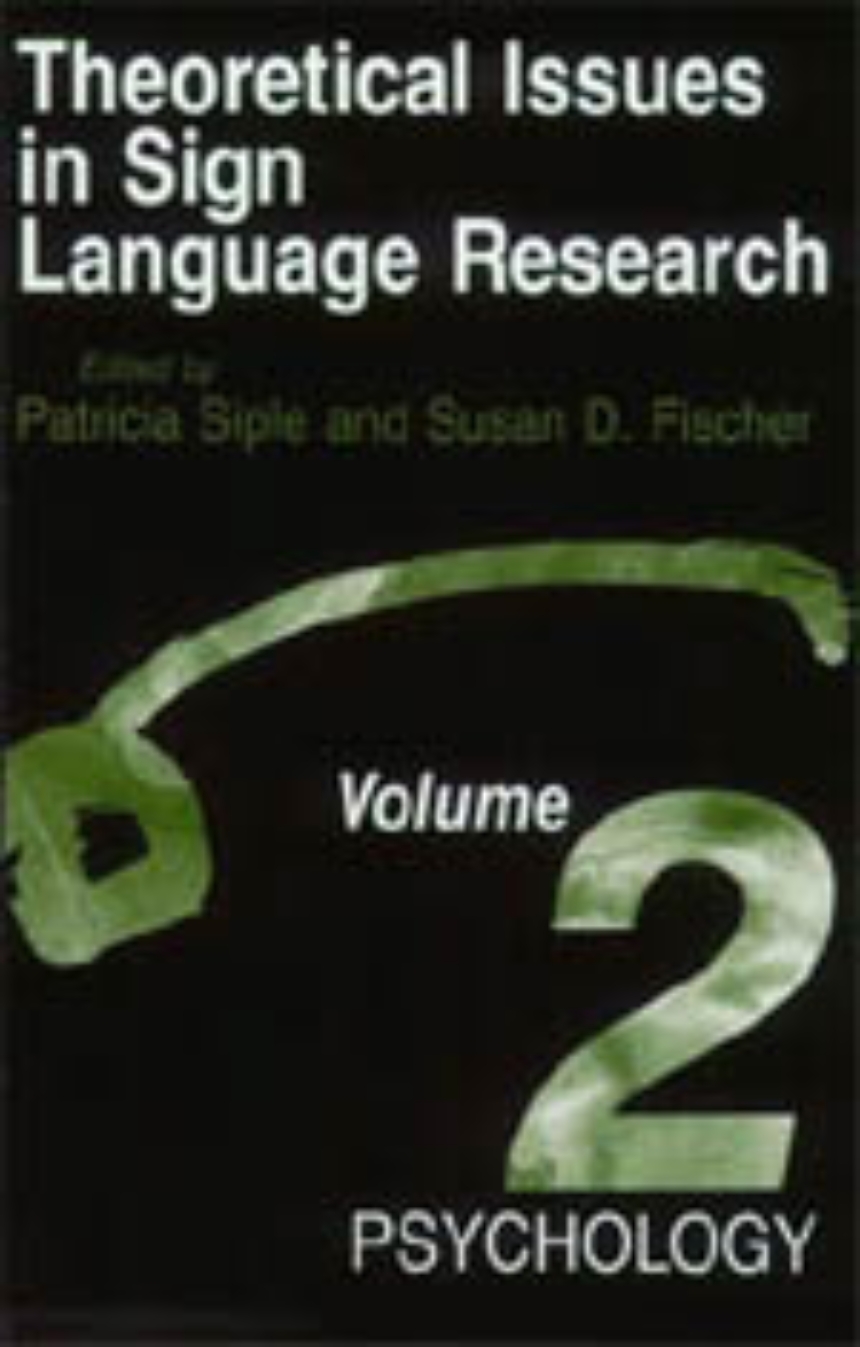Theoretical Issues in Sign Language Research, Volume 2
Psychology
The recent recognition of sign languages as legitimate human languages has opened up new and unique ways for both theoretical and applied psycholinguistics and language acquisition have begun to demonstrate the universality of language acquisition, comprehension, and production processes across a wide variety of modes of communication. As a result, many language practitioners, teachers, and clinicians have begun to examine the role of sign language in the education of the deaf as well as in language intervention for atypical, language-delayed populations.
This collection, edited by Patricia Siple and Susan D. Fischer, brings together theoretically important contributions from both basic research and applied settings. The studies include native sign language acquisition; acquisition and processing of sign language through a single mode under widely varying conditions; acquisition and processing of bimodal (speech and sign) input; and the use of sign language with atypical, autistic, and mentally retarded groups.
All the chapters in this collection of state-of-the-art research address one or more issues related to universality of language processes, language plasticity, and the relative contributions of biology and input to language acquisition and use.
This collection, edited by Patricia Siple and Susan D. Fischer, brings together theoretically important contributions from both basic research and applied settings. The studies include native sign language acquisition; acquisition and processing of sign language through a single mode under widely varying conditions; acquisition and processing of bimodal (speech and sign) input; and the use of sign language with atypical, autistic, and mentally retarded groups.
All the chapters in this collection of state-of-the-art research address one or more issues related to universality of language processes, language plasticity, and the relative contributions of biology and input to language acquisition and use.
324 pages | 26 line drawings, 41 tables | 6 x 9 | © 1991
Cognitive Science: Language
Language and Linguistics: Language Studies, Syntax and Semantics
Table of Contents
Foreword by James J. DeCaro
Introduction by Patricia Siple and Susan D. Fischer
1. Baby Face: A New Perspective on Universals in Language Acquisition
Judy Snitzer Reilly, Marina L. McIntire, and Ursula Bellugi
2. Emergence of American Sign Language in a Set of Fraternal Twins
Patricia Siple and C. Tane Akamatsu
3. Home Sign Systems in Deaf Children: The Development of Morphology without a Conventional Language Model
Carolyn Mylander and Susan Goldin-Meadow
4. Nativization, Variability, and Style Shifting in the Sign Language Development of Deaf Children of Hearing Parents
James Paul Gee and Judith L. Mounty
5. Manually Coded English: The Modality Question in Signed Language Development
Samuel J. Supalla
6. Conversational Interaction between Deaf Children and Their Hearing Mothers: The Role of Visual Attention
M. Virginia Swisher
7. The Effects of Bimodal Communication on the Intelligibility of Sign and Speech
Susan D. Fischer, Dale Evan Metz, Paula M. Brown, and Frank Caccamise
8. The Manual Representation of Speech by Deaf Children, Their Mothers, and Their Teachers
Rhonda Wodlinger-Cohen
9. Bimodal Language Production
Madeline Maxwell, Mark E. Bernstein, and Kimberly Matthews Mear
10. The Acquisition of Fingerspelling by Deaf Children
Carol A. Padden
11. Children’s Memory for Sign and Fingerspelling in Relation to Production Rate and Sign Language Input
Rachel I. Mayberry and Gloria S. Waters
12. Boundary Conditions on Language Emergence: Contributions from Atypical Learners and Input
Adele Abrahamsen, Maureen Lamb, Jacqueline Brown-Williams, and Susan McCarthy
13. Manual Communication and Autism: Factors Relating to Sign Language and Acquisition
John D. Bonvillian and Deborah Webb Blackburn
References
Author Index
Subject Index
Introduction by Patricia Siple and Susan D. Fischer
1. Baby Face: A New Perspective on Universals in Language Acquisition
Judy Snitzer Reilly, Marina L. McIntire, and Ursula Bellugi
2. Emergence of American Sign Language in a Set of Fraternal Twins
Patricia Siple and C. Tane Akamatsu
3. Home Sign Systems in Deaf Children: The Development of Morphology without a Conventional Language Model
Carolyn Mylander and Susan Goldin-Meadow
4. Nativization, Variability, and Style Shifting in the Sign Language Development of Deaf Children of Hearing Parents
James Paul Gee and Judith L. Mounty
5. Manually Coded English: The Modality Question in Signed Language Development
Samuel J. Supalla
6. Conversational Interaction between Deaf Children and Their Hearing Mothers: The Role of Visual Attention
M. Virginia Swisher
7. The Effects of Bimodal Communication on the Intelligibility of Sign and Speech
Susan D. Fischer, Dale Evan Metz, Paula M. Brown, and Frank Caccamise
8. The Manual Representation of Speech by Deaf Children, Their Mothers, and Their Teachers
Rhonda Wodlinger-Cohen
9. Bimodal Language Production
Madeline Maxwell, Mark E. Bernstein, and Kimberly Matthews Mear
10. The Acquisition of Fingerspelling by Deaf Children
Carol A. Padden
11. Children’s Memory for Sign and Fingerspelling in Relation to Production Rate and Sign Language Input
Rachel I. Mayberry and Gloria S. Waters
12. Boundary Conditions on Language Emergence: Contributions from Atypical Learners and Input
Adele Abrahamsen, Maureen Lamb, Jacqueline Brown-Williams, and Susan McCarthy
13. Manual Communication and Autism: Factors Relating to Sign Language and Acquisition
John D. Bonvillian and Deborah Webb Blackburn
References
Author Index
Subject Index
